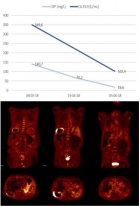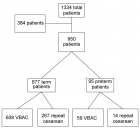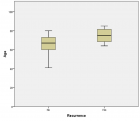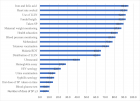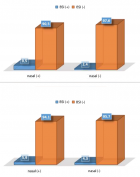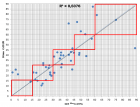Abstract
Review Article
Current challenges in plant breeding to achieve zero hunger and overcome biotic and abiotic stresses induced by the global climate changes: A review
Gniech Karasawa Marines Marli*
Published: 28 July, 2021 | Volume 5 - Issue 2 | Pages: 053-057
According Sustainable Development goals until 2030 we should have zero hunger and undernourished people in the world. But to achieve this goal plant breeders must improve plants in order to produce at least the double than is produced now. This is not a easy pathway because we have only few years, but considering that plant breeding programs normally take several years to produce improved genotypes, also the further improved plants should face with pest, disease and other abiotic factors that are increasing with the current climate changes. In this review we will discuss the situation of hunger in the world and the remaining available land to increase food production, point out effects of biotic and abiotic factors on the food production and present some ways that can be used to fastening plant breeding.
Read Full Article HTML DOI: 10.29328/journal.jpsp.1001060 Cite this Article Read Full Article PDF
Keywords:
Pest; Disease; Abiotic factors; Sustainable development; Molecular breeding; Biotechnology techniques
References
- Bekeko Z, Mulualem T. Genetics of plant–pathogen interactions and resistance. J Gene Environ Resour Conservat. 2016; 4: 123-134.
- World food and agriculture statistical pocketbook 2020. Rome.2020. http://www.fao.org/documents/card/en/c/cb1521en/
- Tilman D. Global food demand and the sustainable intensification of agriculture. Proc Nat Academy Sci. 2011; 108: 20260-20264.
- Ray DK, Mueller ND, West PC, Foley JA. Yield trends are insufficient to double global crop production by 2050. PloS One. 2013; 8: e66428. PubMed: https://pubmed.ncbi.nlm.nih.gov/23840465/
- United Nations, DESA, Population Division. World population prospects 2019, Volume II: Demografic profiles (ST/ESA/SER.A/427). 2019.
- Steinwand MA, Ronald PC. Crop biotechnology and the future of food. Nat Food. 2020; 1: 273-283.
- World food and agriculture statistical pocketbook 2019. Rome. 2019. http://www.fao.org/3/ca6463en/ca6463en.pdf
- Laborde D, Martin W, Swinnen J, Vos R. COVID-19 risks to global food security. Science. 2020; 369: 500-502. PubMed: https://pubmed.ncbi.nlm.nih.gov/32732407/
- Torero M. Without food, there can be no exit from the pandemic. Nature. 2020. https://www.nature.com/articles/d41586-020-01181-3?faodatalab=2020-04-23
- FAO-WFP. Hunger hotspots: FAO-WFP early warning on acute food insecurity (March to July outlook). 2020. https://www.wfp.org/publications/fao-wfp-early-warning-analysis-acute-food-insecurity-hotspots-november-2020
- Dormatey R, Sun C, Ali K, Coulter JA, Bi Z, et al. Gene pyramiding for sustainable Crop improvement against biotic and abiotic stresses. Agronomy. 2020; 10: 1255.
- Rodriguez M, Canales E, Borras-Hidalgo O. Molecular aspects of abiotic stress in plants. Biotecnologia Aplicada. 2005; 2: 1-10.
- De Storme N, Geelen D. high temperatures alter cross-over distribution and induce male meiotic restitution in Arabidopsis thaliana. Commun Biol. 2020; 3: 1-15. PubMed: https://pubmed.ncbi.nlm.nih.gov/32327690/
- Ray DK, Gerber JS, MacDonald GK, West PC. Climate variation explains a third of global crop yield variability. Nature Commun. 2015; 6: 5989.
- Mousavi S, Regni L, Bocchini M, Mariotti R, Cultrera NG, et al. Physiological, epigenetic and genetic regulation in some olive cultivars under salt stress. Sci Rep. 2019; 9: 1093.
- Zhao C, Zhang H, Song C, Zhu JK, Shabala S. Mechanisms of plant responses and adaptation to soil salinity. The innovation. 2020; 1: 100017.
- Faraji S, Filiz E, Kazemitabar SK, Vannozzi A, Palumbo F, et al. The AP2/ERF gene family in Triticum durum: genome-wide identification and expression analysis under drought and salinity stresses. Genes. 2020; 11: 1464.
- Chang YN, Zhu C, Jiang J, Zhang H, Zhu JK, et al. Epigenetic regulation in plant abiotic stress responses. J Integr Plant Biol. 2020; 62: 563-580. PubMed: https://pubmed.ncbi.nlm.nih.gov/31872527/
- Banerjee A, Roychoudhury A. Epigenetic regulation during salinity and drought stress in plants: Histone modifications and DNA methylation. Plant Gene. 2017; 11: 199-204.
- Lucas JA. Plant Pathology and Plant Pathogens. 4th Ed. John Willey & Sons. 2020; 432.
- Kim JH, Hilleary R, Seroka A, He SY. Crops of the future: building a climate-resilient plant immune system. Curr Opin Plant Biol. 2021; 60: 101997. PubMed: https://pubmed.ncbi.nlm.nih.gov/33454653/
- Agrios GN. Plant Pathology. 5nd ed. San Diego: Elsevier. 2005.
- Hammond-Kosack KE, Jones JDG. Responses to plant-pathogens. In: Buchanan, B.B, Gruissen, W, Jones, R.L. Biochemistry and molecular biology of plants. 2nd ed. Oxford: Willey Blackwell. Chapter 21. 2015.
- Hulak N, González Plaza JJ. Plant-Pathogen Interactions: A Brief Insight into a Complicated Story. Agricul Conspectus Sci. 2015; 80: 217-222.
- Camargo LEA. Genética da interação patógeno-hospedeiro. In. Amorim, L, Rezende, J.A.M, Bergamin Filho, A. Manual de fitopatologia: princípios e conceitos. 5ª ed, Viçosa: Ceres, Cap. 156. 2018a.
- Pascholati SFP, Dalio RJD. Fisiologia do parasitismo: como os patógenos atacam as plantas. In. Amorim, L, Rezende, J.A.M, Bergamin Filho, A. Manual de fitopatologia. 5ª ed, Viçosa: Ceres, Cap. 34. 2018b.
- Camargo LEA. Contole genético. In. Amorim L, Rezende JAM, Bergamin Filho A. Manual de fitopatologia: princípios e conceitos. 5ª ed, Viçosa: Ceres, Cap. 15. 2018.
- Kaur B, Bhatia D, Mavi GS. Eighty years of gene-for-gene relationships and its application and utilization of R genes. J Gen. 2021; 100: 50. PubMed: https://pubmed.ncbi.nlm.nih.gov/34282731/
- Meisrimler CN, Allan C, Eccersall S, Morris RJ. Interior design: how plant pathogens optimize their living conditions. New Phytologist. 2021; 229: 2514-2524.
- Karasawa MMG, Pinto JEBP, Pinto JC, Pereira AV. Proliferação de capim elefante em diferentes concentrações de regulador de crescimento e consistências do meio de cultura. Ciência e Agrotecnologia. 2002; 26: 1243-1251.
- Karasawa MMG, Chiancone B, Gianguzzi V, Abdelgalel AM, Botta R, et al. Gametic embryogenesis through isolated microspore culture in Corylus avellana L. Plant Cell, Tissue and Organ Culture (PCTOC). 2021; 124: 635-647.
- Chiancone B, Karasawa MMG, Gianguzzi V, Abdelgalel AM, Bárány I, et al. Early embryo achievement through isolated microspore culture in Citrus clementina Hort. ex Tan, cvs.‘Monreal Rosso’and ‘Nules’. Frontiers in plant science. 2015; 6: 413.
- Gniech-Karasawa MM. Gametic embryogenesis, somatic embryogenesis, plant cell cultures, and protoplast fusion: Progress and Opportunities in Biofuel Production. Plant-Based Genetic Tools for Biofuels Production. 2017; 15.
- Gerald NDLF, Frei UK, Lübberstedt T. Accelerating plant breeding. Trends Plant Sci. 2013; 18: 667-672. PubMed: https://pubmed.ncbi.nlm.nih.gov/24080381/
- Bhardwaj A, Devi P, Chaudhary S, Rani A, Jha UC, Kumar S, et al. ‘Omics’ approaches in developing combined drought and heat tolerance in food crops. Plant Cell Rep. 2021; 1-41. PubMed: https://pubmed.ncbi.nlm.nih.gov/34223931/
- Biswas S, Zhang D, Shi J. CRISPR/Cas systems: opportunities and challenges for crop breeding. Plant Cell Rep. 2021; 40: 979-998.
- Qaim M. Role of new plant breeding technologies for food security and sustainable agricultural development. Appl Econo Perspect Policy. 2020; 42: 129-150.
- Liu S, Geng S, Li A, Mao Y, Mao L. RNAi technology for plant protection and its application in wheat. BIOTECH. 2021; 1-10.
- Dalakouras A, Wassenegger M, Dadami E, Ganopoulos I, Pappas ML, et al. Genetically modified organism-free RNA interference: exogenous application of RNA molecules in plants. Plant Physiol. 2020; 182: 38-50. PubMed: https://pubmed.ncbi.nlm.nih.gov/31285292/
- Sinha SK, Patil BL. Applications of RNA-Interference and Virus-Induced Gene Silencing (VIGS) for Nutritional Genomics in Crop Plants. Phytonutritional Improvement of Crops. 2017; 185.
- Yadav AN, Kour D, Kaur T, Devi R, Guleria G, et al. Microbial biotechnology for sustainable agriculture: current research and future challenges. New and Future Developments in Microbial Biotechnology and Bioengineering. 2020; 331-344.
- Okungbowa FI, Shittu HO, Obiazikwor HO. Endophytic Bacteria: Hidden Protective Associates of Plants against Biotic and Abiotic Stresses. Notulae Scientia Biologicae. 2019; 11: 167-174.
- Lu J, Guan P, Gu J, Yang X, Wang F, et al. Exogenous DA-6 improves the low night temperature tolerance of tomato through regulating cytokinin. Front Plant Sci. 2021; 11: 599111. PubMed: https://pubmed.ncbi.nlm.nih.gov/33613581/
- Zhang J, Li S, Cai Q, Wang Z, Cao J, et al. Exogenous diethyl aminoethyl hexanoate ameliorates low temperature stress by improving nitrogen metabolism in maize seedlings. PloS One. 2020; 15: e0232294. PubMed: https://pubmed.ncbi.nlm.nih.gov/32353025/
- Zhang C, He P, Li Y, Li Y, Yao H, et al. Exogenous diethyl aminoethyl hexanoate, a plant growth regulator, highly improved the salinity tolerance of important medicinal plant Cassia obtusifolia L. J Plant Growth Regula. 2016; 35: 330-344.
- Naliwajski M, Skłodowska M. The relationship between the antioxidant system and proline metabolism in the leaves of cucumber plants acclimated to salt stress. Cells. 2021; 10: 609. PubMed: https://www.ncbi.nlm.nih.gov/pmc/articles/PMC7998282/
- Ghaffari H, Tadayona MR, Bahadora M, Razmjoob J. Investigation of the proline role in controlling traits related to sugar and root yield of sugar beet under water deficit conditions. Agri Water Management. 2021; 243: 106448.
- United Nations DESA. Sustainable development goals. 2015; https://sdgs.un.org/goals
- Kilian B, Dempewolf H, Guarino L, Werner P, Coyne C, et al. Crop Science special issue: Adapting agriculture to climate change: A walk on the wild side. Crop Sci. 2021; 61: 32-36.
- Dwivedi SL, Scheben A, Edwards D, Spillane C, Ortiz R. Assessing and exploiting functional diversity in germplasm pools to enhance abiotic stress adaptation and yield in cereals and food legumes. Front Plant Sci. 2017; 8: 1461. PubMed: https://pubmed.ncbi.nlm.nih.gov/28900432/
- Jones H, Gosman N, Horsnell R, Rose GA, Everest LA, et al. Strategy for exploiting exotic germplasm using genetic, morphological, and environmental diversity: the Aegilops tauschii Coss. example. Theor Appl Gene. 2016; 126: 1793-1808. PubMed: https://pubmed.ncbi.nlm.nih.gov/23558983/
- Palanisamy D, Marappan S, Ponnuswamy RD, Mahalingam PS, Bohar R, et al. Accelerating hybrid rice breeding through the adoption of doubled haploid technology for R-line development. Biologia. 2019; 74: 1259-1269.
- Cobb JN, Juma RU, Biswas PS, Arbelaez JD, Rutkoski J, et al. Enhancing the rate of genetic gain in public-sector plant breeding programs: lessons from the breeder’s equation. Theo Appl Gene. 2019; 132: 627-645
Figures:

Figure 1
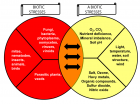
Figure 2
Similar Articles
-
Antagonistic features displayed by Plant Growth Promoting Rhizobacteria (PGPR): A ReviewMohsin Tariq*,Muhammad Noman,Temoor Ahmed,Amir Hameed,Natasha Manzoor,Marriam Zafar. Antagonistic features displayed by Plant Growth Promoting Rhizobacteria (PGPR): A Review . . 2017 doi: 10.29328/journal.jpsp.1001004; 1: 038-043
-
HBV: Genomic Structure, HBVsAg Isolation and innovative Virotherapy Initiation in the Middle EastAboul-Ata E Aboul-Ata*,Essam M Janahi,I M El-Kalamawy,Kathleen Hefferon,Amal Mahmoud. HBV: Genomic Structure, HBVsAg Isolation and innovative Virotherapy Initiation in the Middle East . . 2017 doi: 10.29328/journal.jpsp.1001007; 1: 059-061
-
Studies of Grafts in vegetables, an alternative for agricultural production under stress conditions: Physiological responsesEdgar Omar Rueda Puente*,Jose Bernal Alzate,Onécimo Grimaldo Juárez,Daniel González Mendoza,Lourdes Cervantes Díaz,Alejandro García López. Studies of Grafts in vegetables, an alternative for agricultural production under stress conditions: Physiological responses. . 2018 doi: 10.29328/journal.jpsp.1001014; 2: 006-014
-
Control of phytopathogenic microorganisms of post-harvest in tomato (Lycopersicon esculentum Mill.) with the use of citrus extractRueda Puente Edgar Omar*,Ruíz-Alvarado Cristina,Juan José Reyes-Pérez,Hernández-Montiel Luis Guillermo,Amador Bernardo. Control of phytopathogenic microorganisms of post-harvest in tomato (Lycopersicon esculentum Mill.) with the use of citrus extract. . 2018 doi: 10.29328/journal.jpsp.1001018; 2: 037-043
-
Detection of Clavibacter michiganensis subsp. michiganensis in tomato and chili seeds and farming area of Sinaloa, MexicoRuiz Alvarado Cristina*,Soto Ortiz Roberto,Cervantes Diaz Lourdes,Nuñez Ramirez Fidel,Celaya-Michel Hernán,Rueda Puente Edgar O. Detection of Clavibacter michiganensis subsp. michiganensis in tomato and chili seeds and farming area of Sinaloa, Mexico. . 2018 doi: 10.29328/journal.jpsp.1001019; 2: 044-054
-
Life history strategies of the armored scale, Aulacaspis alisiana (Hemiptera: Coccoidea: Diaspididae) on the Japanese silver tree Neolitsea sericea (Bl.) Koidz. (Lauraceae) in Fukuoka, JapanCharles AO Midega*,Keiji Takasu. Life history strategies of the armored scale, Aulacaspis alisiana (Hemiptera: Coccoidea: Diaspididae) on the Japanese silver tree Neolitsea sericea (Bl.) Koidz. (Lauraceae) in Fukuoka, Japan. . 2018 doi: 10.29328/journal.jpsp.1001020; 2: 055-058
-
Use of essential oils as new food preservatives (Case: Eucalyptus grandis and Eucalyptus crebra)Sendanyoye Marcel*. Use of essential oils as new food preservatives (Case: Eucalyptus grandis and Eucalyptus crebra). . 2018 doi: 10.29328/journal.jpsp.1001023; 2: 083-090
-
Assessing the stand size of bay trees (Persea spp.) after exposure to laurel wilt disease in a North Florida PreserveAnthony M Rossi*,Christopher Bentzien . Assessing the stand size of bay trees (Persea spp.) after exposure to laurel wilt disease in a North Florida Preserve. . 2019 doi: 10.29328/journal.jpsp.1001030; 3: 042-049
-
Non-chemical control of Armillaria mellea infection of Prunus persicaJim Downer*,Ben Faber. Non-chemical control of Armillaria mellea infection of Prunus persica. . 2019 doi: 10.29328/journal.jpsp.1001031; 3: 050-055
-
Causal agents of Post-harvest Rot of Pumpkin (Cucurbita pepo L.) and their control using Indigenous Practices in Hong, Adamawa StateAnjili SM*,Kazi N,Chimbekujwo IB. Causal agents of Post-harvest Rot of Pumpkin (Cucurbita pepo L.) and their control using Indigenous Practices in Hong, Adamawa State. . 2019 doi: 10.29328/journal.jpsp.1001033; 3: 062-066
Recently Viewed
-
Environmental Factors Affecting the Concentration of DNA in Blood and Saliva Stains: A ReviewDivya Khorwal*, GK Mathur, Umema Ahmed, SS Daga. Environmental Factors Affecting the Concentration of DNA in Blood and Saliva Stains: A Review. J Forensic Sci Res. 2024: doi: 10.29328/journal.jfsr.1001057; 8: 009-015
-
Markov Chains of Molecular Processes of Biochemical MaterialsOrchidea Maria Lecian*. Markov Chains of Molecular Processes of Biochemical Materials. Int J Phys Res Appl. 2024: doi: 10.29328/journal.ijpra.1001076; 7: 001-005
-
Generation of Curved Spacetime in Quantum FieldSarfraj Khan*. Generation of Curved Spacetime in Quantum Field. Int J Phys Res Appl. 2024: doi: 10.29328/journal.ijpra.1001077; 7: 006-009
-
Optimizing Milk Safety: Applying Nuclear Techniques in X-ray Fluorescence Spectroscopy for Heavy Metal Quantification in Powdered Milk Consumed in SenegalPapa Macoumba Faye*, Djicknack Dione, Oumar Ndiaye, Moussa Hamady SY, Nogaye Ndiaye, Alassane Traore, Ababacar Sadikhe Ndao. Optimizing Milk Safety: Applying Nuclear Techniques in X-ray Fluorescence Spectroscopy for Heavy Metal Quantification in Powdered Milk Consumed in Senegal. Int J Phys Res Appl. 2024: doi: 10.29328/journal.ijpra.1001078; 7: 010-015
-
Thermoelectric Materials Based on Lead Telluride and Prospects for their Practical ApplicationYuriy Pavlovskyy*, Nadiya Pavlovska. Thermoelectric Materials Based on Lead Telluride and Prospects for their Practical Application. Int J Phys Res Appl. 2024: doi: 10.29328/journal.ijpra.1001079; 7: 016-018
Most Viewed
-
Evaluation of Biostimulants Based on Recovered Protein Hydrolysates from Animal By-products as Plant Growth EnhancersH Pérez-Aguilar*, M Lacruz-Asaro, F Arán-Ais. Evaluation of Biostimulants Based on Recovered Protein Hydrolysates from Animal By-products as Plant Growth Enhancers. J Plant Sci Phytopathol. 2023 doi: 10.29328/journal.jpsp.1001104; 7: 042-047
-
Sinonasal Myxoma Extending into the Orbit in a 4-Year Old: A Case PresentationJulian A Purrinos*, Ramzi Younis. Sinonasal Myxoma Extending into the Orbit in a 4-Year Old: A Case Presentation. Arch Case Rep. 2024 doi: 10.29328/journal.acr.1001099; 8: 075-077
-
Feasibility study of magnetic sensing for detecting single-neuron action potentialsDenis Tonini,Kai Wu,Renata Saha,Jian-Ping Wang*. Feasibility study of magnetic sensing for detecting single-neuron action potentials. Ann Biomed Sci Eng. 2022 doi: 10.29328/journal.abse.1001018; 6: 019-029
-
Pediatric Dysgerminoma: Unveiling a Rare Ovarian TumorFaten Limaiem*, Khalil Saffar, Ahmed Halouani. Pediatric Dysgerminoma: Unveiling a Rare Ovarian Tumor. Arch Case Rep. 2024 doi: 10.29328/journal.acr.1001087; 8: 010-013
-
Physical activity can change the physiological and psychological circumstances during COVID-19 pandemic: A narrative reviewKhashayar Maroufi*. Physical activity can change the physiological and psychological circumstances during COVID-19 pandemic: A narrative review. J Sports Med Ther. 2021 doi: 10.29328/journal.jsmt.1001051; 6: 001-007

HSPI: We're glad you're here. Please click "create a new Query" if you are a new visitor to our website and need further information from us.
If you are already a member of our network and need to keep track of any developments regarding a question you have already submitted, click "take me to my Query."








